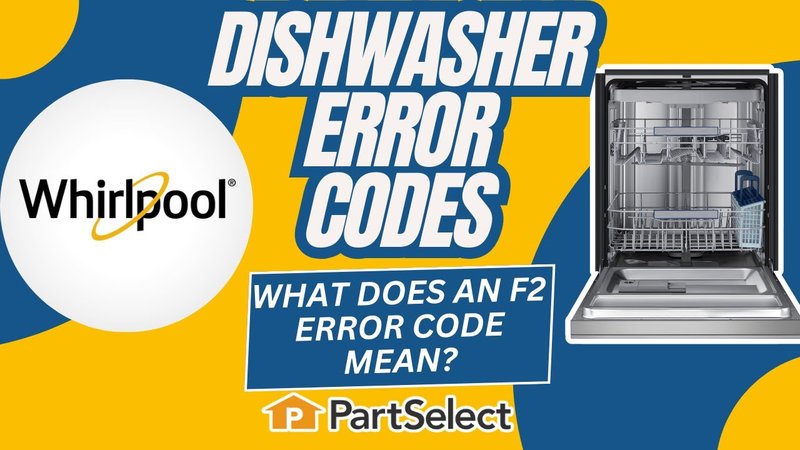
A dishwasher is much more than a kitchen appliance; it’s practically a household hero that saves you countless hours scrubbing plates. When it springs up with an error like F2, it could indicate a significant issue. Error codes are like the appliance’s way of sending you an SOS signal—they need your help. Before you hit the panic button, let’s break down what this error means, why it appears, and whether it’s something you can ignore without worrying too much.
Understanding Error Code F2
Error code F2 in a Whirlpool dishwasher is essentially yelling, “Help, my drain system’s in trouble!” Think of it like a blocked sink—water should flow out, but something’s stopping it. This code doesn’t just appear randomly; it’s a signal that the dishwasher’s drainage system might be malfunctioning. The code could be due to something as simple as a clogged filter or as serious as a failed pump motor.
Why does this happen, you ask? Well, there could be multiple culprits. For example, food particles and grease build up and restrict the flow of water, much like hair clogging your shower drain. As water struggles to get out, it triggers the F2 error. Alternatively, if your dishwasher’s pump isn’t working efficiently, it can’t push the water out as it should, again causing the dreaded error code.
Now, an F2 error isn’t just an inconvenience; it’s a warning. Ignoring it might lead to standing water inside your dishwasher, creating an unpleasant odor and potentially damaging your floors with leaks. Instead of waiting for things to get worse, let’s explore how you can tackle this issue, starting with some initial checks.
Initial Checks and Easy Fixes
So, you’ve got this F2 error on your hands. What’s the first step? Start with the quick and easy checks. It’s kind of like checking if a lamp is plugged in before assuming the bulb is out. First, ensure that the dishwasher isn’t overloaded. Sometimes, rearranging your dishes can solve minor drainage issues that trigger error codes.
Next, check the filter. The filter acts like a net, catching food particles, and is typically found at the bottom of the dishwasher. A clogged filter won’t let water pass through efficiently, leading to drainage problems. Cleaning it is simple: remove the lower rack, twist, and lift the filter out, then rinse it under running water. If it’s clean and the error persists, you might want to examine the drain hose for any kinks or blockages.
Lastly, consider whether there’s a potential blockage in the garbage disposal, if your dishwasher drains through it. A quick disposal check can confirm if that’s the culprit. If after all these checks the error remains, it might be time to investigate further or call in the experts, but there’s still hope before you reach for the phone.
When to Call a Professional
Alright, you’ve done the preliminary checks, cleaned the filter, and ensured there are no visible blockages, but F2 is still flashing at you like an uninvited guest. At this point, it might be tempting to just ignore it, hoping it’ll fix itself magically. However, ignoring an F2 error for too long could end up costing you more in the long run.
Here’s why: the longer your dishwasher runs with drainage issues, the higher the risk of water backing up into the appliance or leaking onto your kitchen floor. Water and electrical components are a risky mix, potentially leading to more significant malfunctions or even safety hazards. So when basic troubleshooting doesn’t do the trick, it’s wise to call in a professional technician who can diagnose more complex issues, like a faulty pump or control board problems.
Professionals can offer a comprehensive service, ensuring every component is functioning correctly. This isn’t only about immediate repair; it’s also about extending the lifespan of your dishwasher. Regular maintenance checks by technicians can prevent future issues, saving you from repeated error code headaches.
Preventative Measures to Avoid Future Errors
Now that you’ve dealt with the F2 error, how do you prevent it from happening again? Just like regular oil changes keep your car running smoothly, a few preventative measures can keep your dishwasher in top shape. Regular cleaning is key. Make it a habit to clean the filter monthly to prevent buildup. It’s a simple task that can save you from bigger hassles.
Use the right amount of detergent. Too much soap is like trying to fix a leaky faucet with a bucket—it doesn’t solve the problem and may cause suds to build up, which leads to drainage issues. Also, ensure you’re loading the dishwasher correctly. Overloading or improper loading can block the spray arms and lead to poor cleaning performance, indirectly contributing to drainage concerns.
Finally, always run the garbage disposal before starting your dishwasher. This ensures the path to the drain is clear. By following these simple tips, you can minimize encounters with error codes, ensuring your Whirlpool dishwasher remains a reliable kitchen companion.
In conclusion, while the F2 error code on your Whirlpool dishwasher might cause initial panic, it’s manageable with the right approach and a bit of knowledge. Address it promptly, maintain your appliance, and you’ll enjoy hassle-free dishwashing for years to come.